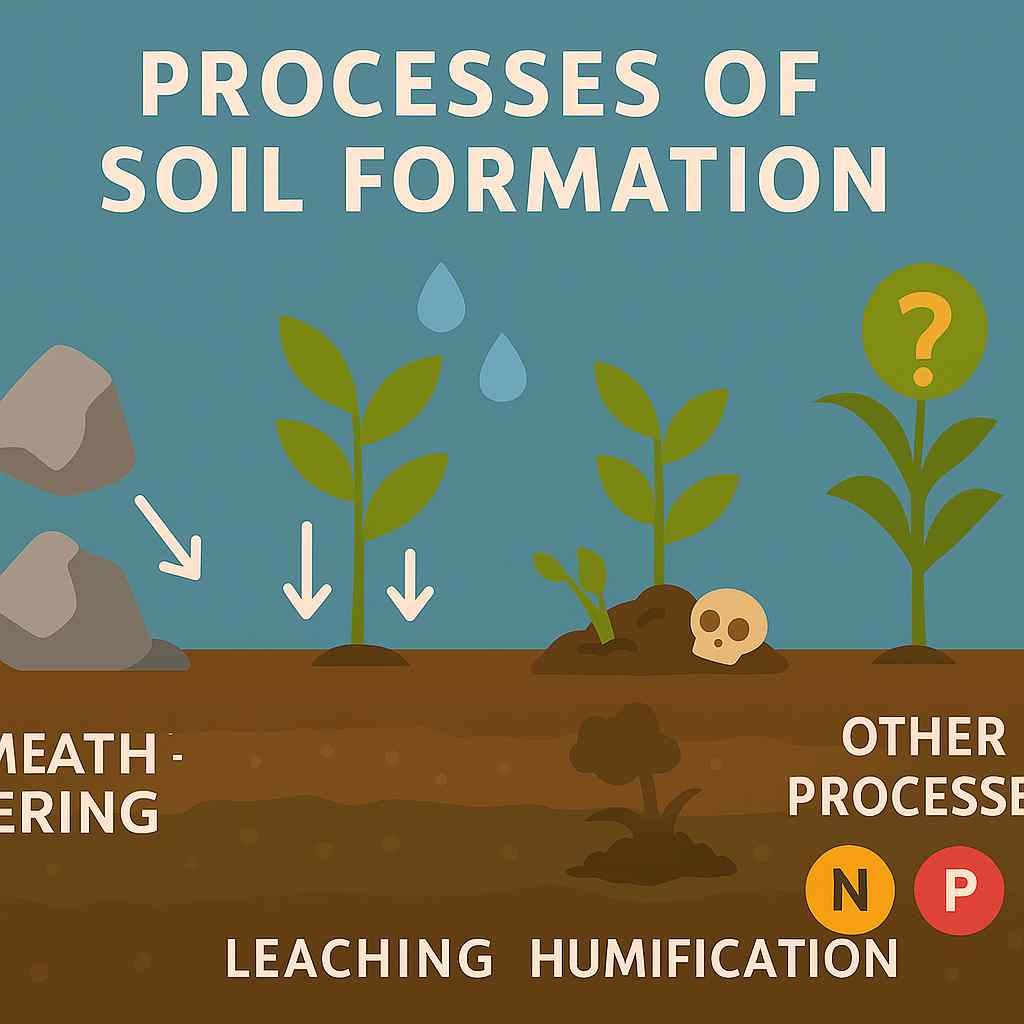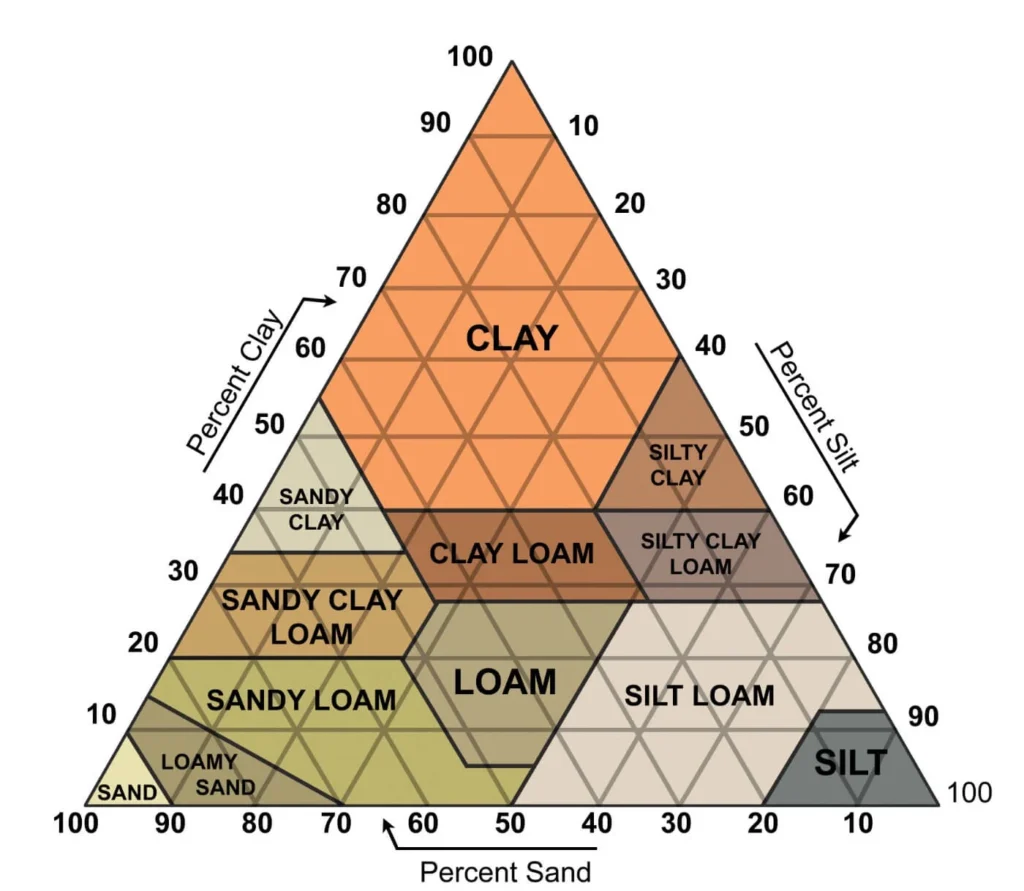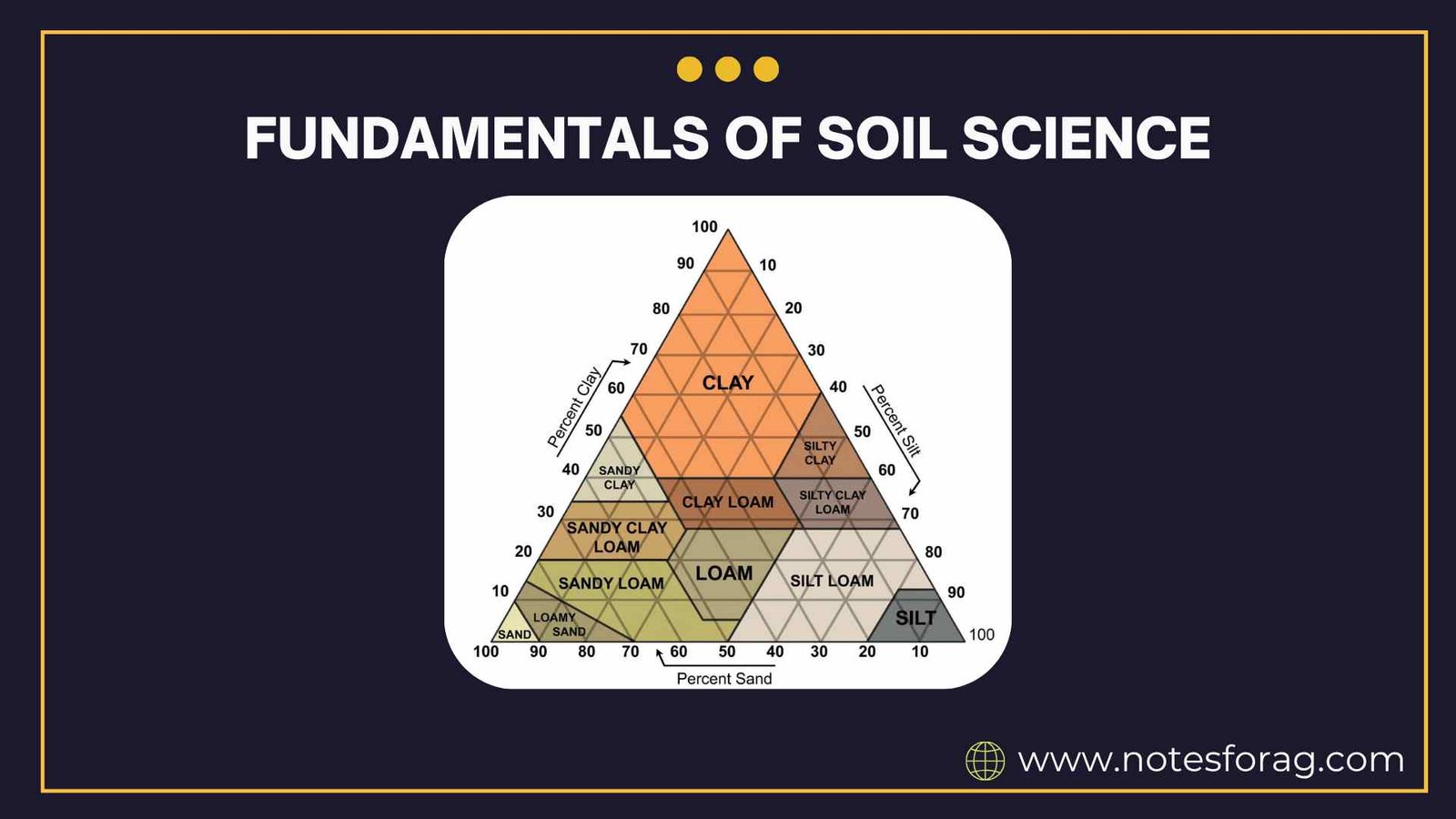Introduction to Soil Science
Soil science is the study of soil as a natural resource. It focuses on understanding how soils form, how they are classified, and how they function. Soils are essential because they provide plants with nutrients, water, and a place for their roots to grow. They also help clean water, recycle nutrients, and store carbon, which helps fight climate change.
Soil science is the study of soils how they form, what they’re made of, and how they work. Soil Science is imprtant because soil supports plant growth, helps clean water, stores carbon for climate, and sustains life. Healthy soil is essential for growing food, maintaining ecosystems, and protecting the environment.
By studying soils, we can improve farming practices, protect the environment, and keep the land healthy for future generations. Understanding soils helps us grow more food in a sustainable way, prevent soil damage, and care for the planet.
Summary of Soil Science
- Soil science teaches us how soils form, function, and support plant growth and environmental health.
- Soil properties, fertility management, and conservation practices are essential for sustainable agriculture and preventing soil degradation.
- Healthy soils are vital for food production, climate protection, clean water, and long-term ecosystem balance.
Table of Contents
Soil Formation
Factors of Soil Formation
Soils form over very long periods of time due to several natural factors working together:
- Parent Material: This is the rock or material that breaks down to become soil. The minerals and chemical makeup of the parent material affect the soil’s texture and nutrient content.
- Climate: Weather, especially temperature and rainfall, affects how fast rocks break down and how organic material decays. Warm, wet climates speed up soil formation, while cold, dry climates slow it down.
- Organisms: Plants, animals, and microbes help form soil by breaking down material and adding organic matter. Worms, insects, and roots mix the soil, and bacteria and fungi decompose dead plants and animals.
- Topography: The shape of the land influences how water moves, how soil erodes, and how deep soils can become. Steep slopes may have thin soils due to erosion, while flat areas can have thick, rich soils.
- Time: Soil formation is a slow process that takes hundreds to thousands of years. The longer the soil forms, the more it develops layers and changes.
Processes of Soil Formation

- Weathering: Rocks break into smaller pieces through physical (like freezing and thawing) and chemical (like reactions with water) processes. Weathering is the starting point for soil formation.
- Leaching: Rainwater moves minerals and nutrients down through the soil layers. Some nutrients are washed away, while others collect deeper in the soil.
- Humification: Dead plants and animals decompose and turn into humus, a dark, rich part of the soil that holds water and nutrients.
- Other Processes: Depending on the environment, special processes like podzolization (in cold, wet areas), laterization (in hot, wet areas), or calcification (in dry areas) can shape the soil’s color, structure, and nutrient levels.
Soil Physical Properties
Soil Texture

- Definition: Soil texture describes the mix of sand, silt, and clay particles in the soil.
- Why It Matters: Texture affects how well soil holds water, how easily roots grow, and how much air is in the soil.
- Types:
- Sandy soils: Have large particles and drain quickly but do not hold nutrients well. Water moves through them easily.
- Loamy soils: Have a balanced mix of sand, silt, and clay. They hold water and nutrients well but still drain properly. Loamy soils are ideal for most crops.
- Clay soils: Have very small particles that hold a lot of water but can become hard, sticky, and poorly drained. These soils are heavy and can be difficult for roots to penetrate.
Soil Structure

- Definition: Soil structure describes how soil particles stick together in clumps or aggregates.
- Types:
- Granular: Small, crumbly pieces, good for plants because they allow water and air to move easily.
- Blocky: Chunky pieces that are common in many soils. They can support plant growth but may slow water movement if tightly packed.
- Platy: Flat, thin layers that can slow water movement and root growth.
- Prismatic: Tall, column-like pieces that may form in clay-rich soils.
- Why It Matters: Good soil structure helps water flow, air move, and roots grow easily. Poor soil structure can lead to hard, compacted soil where plants struggle to grow.
Soil Porosity and Density
- Porosity: Porosity measures how much empty space (pores) is in the soil. Pores hold air and water, both of which are essential for plant roots and soil organisms.
- Bulk Density: Bulk density shows how heavy the soil is in a certain space. If soil is too compacted (high bulk density), roots cannot grow well, water cannot move easily, and plant health suffers.
Soil Color
- Dark soils often have more organic matter, which is good for plant growth.
- Red or yellow soils may have more iron and often indicate good drainage.
- Gray or blueish soils may indicate poor drainage and water-logged conditions.
Soil Chemical Properties
Soil pH
- Definition: pH measures if soil is acidic (low pH), neutral, or alkaline (high pH).
- Why It Matters: Soil pH controls how easily plants can take up nutrients. If pH is too low or too high, plants may not grow well because essential nutrients become unavailable.
- Ideal Range: Most crops grow best when soil pH is between 6.0 and 7.5, where most nutrients are available.
Cation Exchange Capacity (CEC)
- Definition: CEC shows how well soil can hold and exchange nutrients like calcium, magnesium, potassium, and sodium.
- Why It Matters: Soils with high CEC can store more nutrients and release them to plants when needed. Soils with low CEC may lose nutrients quickly through leaching.
Soil Salinity
- Definition: Salinity refers to the amount of dissolved salts in the soil.
- Impact: High salt levels can harm plants by making it harder for them to absorb water. Salt can build up from irrigation, fertilizers, or natural soil processes.
Soil Biological Properties
Soil Microorganisms
- Soil is full of tiny living organisms like bacteria, fungi, algae, protozoa, and actinomycetes.
- These microorganisms help decompose dead plants and animals, which returns nutrients to the soil. They also help fix nitrogen from the air into forms plants can use and protect plants from harmful diseases.
Organic Matter
- Organic matter includes decomposed plant and animal materials. It improves soil structure by helping soil particles stick together.
- Organic matter increases water-holding ability, provides nutrients, and gives energy to soil organisms. Soils rich in organic matter are usually fertile and easy to work.
Soil Water
Water Holding Capacity
Soil holds water in different ways:
- Gravitational Water: Water that drains quickly through the soil and is not available to plants.
- Capillary Water: Water held in small pores that plants can absorb and use. This is the main source of water for plant growth.
- Hygroscopic Water: Water that sticks tightly to soil particles and cannot be taken up by plants.
Field Capacity and Wilting Point
- Field Capacity: The amount of water the soil can hold after extra water has drained away. At this point, the soil has the right amount of water for plants.
- Wilting Point: The soil moisture level when plants can no longer extract enough water to survive, causing them to wilt.
Water Movement
- Infiltration: Water soaks into the soil from the surface.
- Percolation: Water moves downward through the soil layers.
- Capillary Action: Water moves sideways or upwards in the soil through small pores.
Soil Classification
Soil Orders
Soils are grouped into different categories called soil orders based on their features and how they form. Some examples are:
- Entisols: Very young soils with little development. These are often found in areas where new soil is forming quickly.
- Inceptisols: Soils that are starting to develop some layers but are still young.
- Oxisols: Very old, heavily weathered soils found in tropical regions. They are low in nutrients but can still support plants with good management.
- Vertisols: Soils with a lot of clay that shrink when dry and swell when wet. They often crack and can be hard to farm.
- Mollisols: Fertile soils, usually dark and rich in organic matter. Common in grasslands and excellent for farming.
- Alfisols: Soils that are fairly fertile and common in forests and grasslands. They have good structure and are used for many types of crops.
Soil Fertility and Nutrient Management
Essential Elements for Plants
Plants need 17 essential elements to grow, including:
- Macronutrients: Nitrogen (N) for leafy growth, Phosphorus (P) for roots and flowers, Potassium (K) for strong stems and disease resistance, Calcium (Ca), Magnesium (Mg), and Sulfur (S) for overall plant health.
- Micronutrients: Small amounts of Iron (Fe), Manganese (Mn), Zinc (Zn), Copper (Cu), Boron (B), Molybdenum (Mo), Chlorine (Cl), and Nickel (Ni) are also vital for plant growth.
Soil Fertility
Soil fertility means the soil has enough nutrients, in the right balance, and in a form that plants can use. Fertile soils also have good structure, enough organic matter, and proper pH.
Soil Amendments
- Adding compost, manure, fertilizers, lime, or gypsum can improve soil fertility, structure, and pH. Organic amendments improve soil over time, while chemical fertilizers give quick nutrients.
Fertilizer Management
- Using the right type, amount, and timing of fertilizer ensures plants get the nutrients they need while reducing the risk of pollution from fertilizer runoff.
Soil Degradation and Conservation
Causes of Soil Degradation
Soil can be damaged by:
- Erosion: Wind and water remove the top layer of soil, which is rich in nutrients.
- Salinization: Salt builds up in the soil, often due to improper irrigation.
- Nutrient Depletion: Soils lose nutrients if crops are grown without adding back fertilizers or organic matter.
- Compaction: Heavy machinery or overgrazing can press the soil tightly together, making it hard for water, air, and roots to move through.
- Pollution: Chemicals like pesticides and heavy metals can harm soil health and living organisms.
Soil Conservation Practices
- Contour Farming: Planting along the natural curves of the land to slow water runoff and prevent erosion.
- Terracing: Building steps on hillsides to reduce soil loss.
- Cover Cropping: Growing plants like grasses or legumes between main crops to protect the soil.
- Mulching: Covering the soil with straw, leaves, or plastic to prevent erosion and hold moisture.
- Reduced Tillage: Disturbing the soil less to maintain its structure and reduce erosion.
- Agroforestry: Planting trees along with crops to protect the soil and improve biodiversity.
Sustainable Soil Management
- Sustainable soil management focuses on keeping soils healthy for the long term by adding organic matter, rotating crops, using fewer chemicals, and practicing conservation tillage. These practices help keep the soil productive while protecting the environment.
Soil and Environmental Quality
- Soils help filter and clean water before it reaches rivers, lakes, or underground supplies.
- Healthy soils store carbon, which helps slow down climate change by reducing carbon dioxide in the air.
- Good soils support a wide variety of living things, recycle nutrients, purify water, and help regulate temperature and water flow in the environment.
Conclusion
Soil science is the foundation of agriculture, environmental protection, and sustainable land use. Soils are more than just dirt; they are complex, living systems that provide essential nutrients, water, and a supportive structure for plants to grow. They also help regulate our environment by cleaning water, storing carbon, and supporting biodiversity. The formation of soil is a slow, natural process influenced by many factors such as parent material, climate, organisms, landscape shape, and time. Understanding soil physical properties like texture, structure, porosity, and color helps farmers and scientists manage soils effectively. These properties influence how soil holds water, how easily roots grow, and how well plants can access air and nutrients.
Chemical properties like pH, cation exchange capacity, and salinity are also crucial because they affect nutrient availability and plant health. In addition, biological factors, especially soil organisms and organic matter, play an important role in keeping soils healthy and fertile. Water movement and water-holding capacity in soil directly impact plant growth, and learning about how water interacts with different soil types helps improve irrigation and water conservation.
Soil classification helps us understand different soil types around the world and choose suitable crops and management practices. Maintaining soil fertility through proper nutrient management and soil amendments is essential for sustainable farming. Soil degradation from erosion, nutrient loss, salinity, compaction, and pollution is a serious threat, but we can protect soils through conservation practices like contour farming, cover cropping, mulching, and reduced tillage.
Healthy soils are key to feeding a growing global population and combating climate change. By taking care of soils today, we ensure that they can continue to support life, store carbon, and provide clean water for future generations. Soil science empowers us to use the land wisely and responsibly.
Frequently Asked Questions (FAQs)
What is soil science, and why is it important?
Soil science is the study of soils how they form, what they’re made of, and how they work. Soil Science is imprtant because soil supports plant growth, helps clean water, stores carbon for climate, and sustains life. Healthy soil is essential for growing food, maintaining ecosystems, and protecting the environment.
Why is soil pH important?
Soil pH tells us how acidic or alkaline the soil is. It affects whether plants can absorb nutrients. Most crops grow best in soils with pH between 6.0 and 7.5.
How do soil organisms benefit soil?
Microorganisms like bacteria, fungi, and earthworms break down organic matter, cycle nutrients, fix nitrogen, and improve soil structure. Their activity helps maintain fertile, healthy soil.
Related Articles

